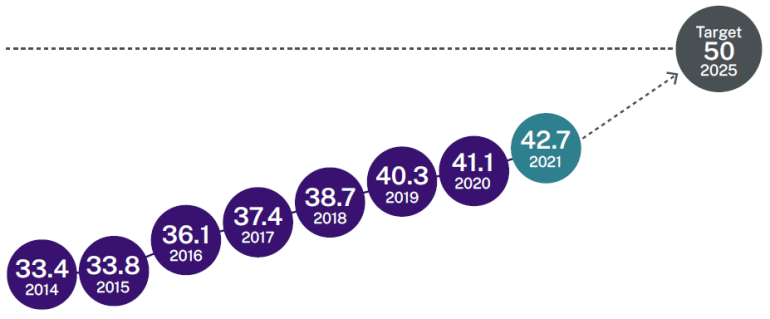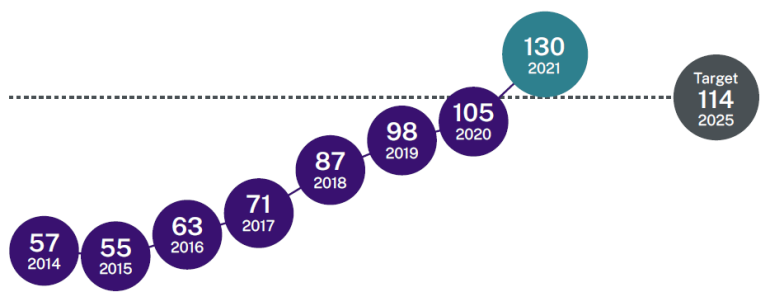Senior executives in the government sector
3,680
senior executives in the government sector
+10.4pp vs 2020
Note: ‘pp’ stands for percentage points.
A key objective of the Government Sector Employment Act 2013 was to create a simpler executive structure that gives this cohort greater mobility across the sector. The Government Sector Employment Legislation Amendment Act 2016 supported this by aligning the senior executive employment arrangements of the NSW Health Service, Transport Service and NSW Police Force with those of the Public Service.
Table 3.1: Senior executives in public sector, census headcount, 2020–21
| Service | 2020 | 2021 | Change (%) |
|---|---|---|---|
| Public Service | 2,098 | 2,280 | 8.7 |
| NSW Health Service | 188 | 200 | 6.4 |
| NSW Police Force | 74 | 74 | 0.0 |
| Transport Service | 675 | 854 | 26.5 |
| Other Crown services | 298 | 272 | -8.7 |
| Total government sector | 3,333 | 3,680 | 10.4 |
| State owned corporations | 243 | 281 | 15.6 |
| External to government sector | 61 | 58 | -4.9 |
| Total public sector | 3,637 | 4,019 | 10.5 |
At June 2021, there were 4,019 senior executives in the public sector. Of these, 3,680 were in the government sector, which was a 10.4% increase, compared to the previous year.
Across services in the government sector, the largest growth occurred in the Transport Service (+179 or 26.5%) and the Public Service (+182 or 8.7%). The number of senior executives increased by 125 at Transport for NSW and 55 at Sydney Metro, compared to 2020. These increases reflect the growing portfolio of major infrastructure projects in NSW.
There were 2,280 senior executives in the Public Service in 2021, an increase of 182 compared to 2020 (see Figure 3.1).
Table 3.2: Senior executives in the Public Service by cluster, census headcount, 2020-21
| Cluster | 2020 | 2021 | Change | Change (%) |
|---|---|---|---|---|
| Customer Service | 254 | 258 | 4 | 1.6 |
| Education | 372 | 416 | 44 | 11.8 |
| Health | 116 | 114 | -2 | -1.7 |
| Planning, Industry and Environment | 436 | 489 | 53 | 12.2 |
| Premier and Cabinet | 240 | 315 | 75 | 31.3 |
| Regional NSW | 143 | 166 | 23 | 16.1 |
| Stronger Communities | 388 | 409 | 21 | 5.4 |
| Transport | 1 | 1 | 0 | 0.0 |
| Treasury | 148 | 112 | -36 | -24.3 |
| Total | 2,098 | 2,280 | 182 | 8.7 |
The number of senior executives increased across most clusters in the Public Service, as shown in Table 3.2. The largest increase occurred in the Premier and Cabinet cluster (+75 or 31.3%), which was largely due to the establishment of Investment NSW. Destination NSW, and Jobs, Investment and Tourism moved from the Treasury cluster to Investment NSW, leading to the decrease in Treasury. Also, the Western Parkland City Authority moved from the Treasury cluster to the Premier and Cabinet cluster.
The Planning, Industry and Environment cluster also had an increase in senior executives (+53 or 12.2%). More than 80% of this increase (43) was in the Department of Planning, Industry and Environment. This reflects the project and program requirements of the NSW economic and social recovery plan, as well as the establishment of Water Infrastructure NSW and the Energy Corporation of NSW.
The increase in Education was partly due to 26 TAFE Commission Senior Executives becoming classified as Public Service senior executives due to a change in their employment arrangements.
Figure 3.2 shows that in 2021, 78.1% of Public Service senior executives (PSSEs) and aligned services executives were classified as Senior Executive Band 1, while 17.7% were in Band 2 and only 4.2% were in Band 3. The distribution of PSSEs and aligned services senior executives between bands is similar, with 77.0% of PSSEs and 80.0% of aligned services senior executives at Band 1, 18.6% and 16.3% at Band 2, and 4.5% and 3.7% at Band 3, respectively.
Premier's Priority for diversity in the senior leader cohort
Percentage of female senior leaders

| 2014 | 2015 | 2016 | 2017 | 2018 | 2019 | 2020 | 2021 |
|---|---|---|---|---|---|---|---|
| 33.4% | 33.8% | 36.1% | 37.4% | 38.7% | 40.3% | 41.1% | 42.7% |
Target: 50.0% by 2025
Number of Aboriginal and Torres Strait Islander senior leaders

| 2014 | 2015 | 2016 | 2017 | 2018 | 2019 | 2020 | 2021 |
|---|---|---|---|---|---|---|---|
| 57 | 55 | 63 | 71 | 87 | 98 | 105 | 130 |
Target: 114 by 2025
One component of the Premier’s Priority for a world class public service is driving senior leader diversity.1 The priority includes targets to achieve gender equity in senior leaders and increase the number of Aboriginal and Torres Strait Islander people in senior leadership roles by 2025.
There has been steady progress towards achieving these targets since the Premier’s Priority was announced in 2014. The proportion of female senior leaders increased by 1.6pp to 42.7% in 2021. Since 2014, female representation in each band has largely increased each year, and cumulatively is up 8.9pp for Band 1 senior leaders, 12.2pp for Band 2 and 16.7pp for Bands 3 and 4. Higher salary bands had fewer women than men, but the gap has narrowed since the target was introduced. Since 2016, the proportion of female leaders in Bands 3 and 4 combined has increased at around double the rate for Band 1 roles.
Table 3.3: Female senior leaders by equivalent band, 2014–211
| 2014 (%) | 2015 (%) | 2016 (%) | 2017 (%) | 2018 (%) | 2019 (%) | 2020 (%) | 2021 (%) | |
|---|---|---|---|---|---|---|---|---|
| Band 1 | 33.9 | 34.4 | 36.6 | 37.7 | 38.8 | 40.5 | 41.2 | 42.8 |
| Band 2 | 30.9 | 31.2 | 35.0 | 37.4 | 40.5 | 40.3 | 42.1 | 43.1 |
| Bands 3 and 4 | 22.2 | 20.8 | 24.8 | 28.3 | 30.6 | 34.6 | 36.2 | 38.9 |
| Total | 33.4 | 33.8 | 36.1 | 37.4 | 38.7 | 40.3 | 41.1 | 42.7 |
Table 3.4: Female senior leaders by cluster, 2020–21
| Cluster | 2020 (%) | 2021 (%) |
|---|---|---|
| Customer Service | 49.9 | 51.1 |
| Education | 56.0 | 56.0 |
| Health | 43.1 | 44.1 |
| Planning, Industry and Environment | 46.5 | 47.7 |
| Premier and Cabinet | 52.9 | 52.6 |
| Regional NSW | 27.7 | 27.4 |
| Stronger Communities | 29.5 | 31.5 |
| Transport | 32.2 | 35.7 |
| Treasury | 45.4 | 42.3 |
| Total public sector | 41.1 | 42.7 |
Female senior leader representation varies across clusters (see Table 3.4).
The Education, Premier and Cabinet, and Customer Service clusters had more than 50% female representation (56.0%, 52.6% and 51.1%, respectively). While the Transport cluster had one of the lowest rates, it improved representation by close to 3.5pp in 2021.
More improvements are needed if the sector is to reach the Premier’s Priority target in 2025. Forecasting based on turnover and gender ratios indicates that the sector will fall 5% short of the target if the current trend continues. Modelling indicates that the NSW Government could reach the target by 2025 if six in every 10 senior leader appointments go to women.
The number of Aboriginal and Torres Strait Islander senior leaders increased from 105 to 130 in 2021, exceeding the Premier’s Priority target for 2025 of 114. This is an exceptional result for the sector. Three clusters accounted for most of the increase: Education (+12), Planning, Industry and Environment (+5) and Premier and Cabinet (+4). The Customer Service, Transport and Treasury clusters also increased their number of senior leaders (+2 each).
Apart from a slight decrease in 2015, the number of Aboriginal and Torres Strait Islander senior leaders has increased each year since 2014, bringing a total increase of 128.1%.
Table 3.5: Aboriginal and Torres Strait Islander senior leaders by band, census headcount, 2014-211
| 2014 | 2015 | 2016 | 2017 | 2018 | 2019 | 2020 | 2021 | |
|---|---|---|---|---|---|---|---|---|
| Band 1 | 52 | 51 | 57 | 63 | 78 | 88 | 97 | 118 |
| Bands 2, 3 and 4 | 5 | 4 | 6 | 8 | 9 | 10 | 8 | 12 |
| Total | 57 | 55 | 63 | 71 | 87 | 98 | 105 | 130 |
Figure 3.4 highlights that while most of the increase in the Aboriginal and Torres Strait Islander cohort occurred in the lower salary range (66 appointments), the number of Aboriginal and Torres Strait Islander senior leaders in Senior Executive Bands 2–4 has increased by 7 since 2014.
Notes
1 Senior leaders are non-casual government sector employees earning $166,247 or more (adjusted annually with wages policy), excluding Health Service roles of a specialist or technical nature with no leadership or managerial responsibilities and Justice roles of a statutory or institutional character (judges, magistrates and barristers). When displayed in bands, these are aligned to the salary ranges of Public Service senior executives. Band 1 includes non‑executives paid below the minimum PSSE salary level.
- Next chapter
Types of work